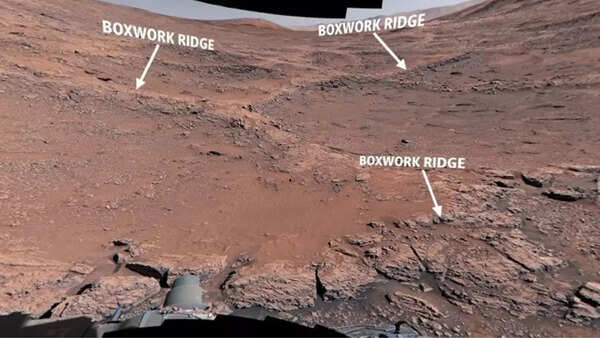NASA's Curiosity rover has transmitted unprecedented close-up images of peculiar, spiderweb-like rock formations on the Martian surface. These intriguing structures offer valuable insights into the planet's ancient, water-rich past.
The intricate, zig-zagging formations, scientifically termed “boxwork,” were identified on the slopes of Mount Sharp within Gale Crater, the area Curiosity has been exploring since 2012. These complex, mineral-rich ridges are believed to have originated from ancient groundwater activity, resembling webs when observed from above. Scientists are optimistic that these formations may contain crucial information about Mars' potential to have supported microbial life in the distant past.

Contrary to their suggestive nickname, these spiderweb-like structures are not biological in origin. They are geological features called boxwork, characterized by intersecting mineral ridges. This pattern emerges as groundwater permeates cracks in the rock, depositing minerals. Over extended periods, wind erosion removes the softer surrounding rock, unveiling the hardened, web-like framework beneath.
While boxwork formations have been observed from orbit previously, this event signifies the first time such formations have been examined in close proximity on Mars. Curiosity reached the site in early June 2025, following months of navigating Mount Sharp. On June 23, NASA released the images and an interactive 3D video of the formations, emphasizing their unique structure and enigmatic location as a top scientific priority.

Analysis of the nearby rocks reveals veins of calcium sulfate, a saline mineral commonly associated with groundwater deposits. These discoveries imply that the region was once abundant in liquid water, and the subterranean environment might have been warm and salty – potentially conducive to microbial life, akin to certain regions on early Earth.
It's important not to confuse these newly imaged boxwork formations with the "spiders on Mars," which are dark, radial patterns caused by carbon dioxide ice erupting from below the surface. Unlike those seasonal features, boxwork is permanent and mineral-based, resulting from geological processes rather than atmospheric ones.
Scientists propose that these formations could contribute to resolving the debate surrounding Mars' potential to have once supported life. The mineral composition, protected subsurface conditions, and evidence of flowing water collectively suggest an environment that could have sustained microbial organisms. According to Curiosity mission scientist Kirsten Siebach, "Early Earth microbes could have survived in a similar environment.”
Curiosity will continue its investigation of this boxwork region on Mount Sharp, collecting samples and performing detailed chemical analyses. Researchers anticipate that these unique structures will not only unveil further details about Mars' climate history but also guide future missions in the search for evidence of life beneath the Martian surface.
Newer articles
 Indian Astronaut Joins ISS: Shukla's Mission Ushers in New Era for India's Space Program
Indian Astronaut Joins ISS: Shukla's Mission Ushers in New Era for India's Space Program
 Ashada Gupt Navratri 2025: Unveiling Dates, Sacred Rituals & Hidden Significance
Ashada Gupt Navratri 2025: Unveiling Dates, Sacred Rituals & Hidden Significance
 Rishabh Pant's Unconventional Batting Redefining Cricket, Says Greg Chappell
Rishabh Pant's Unconventional Batting Redefining Cricket, Says Greg Chappell
 Moto G54 Price Slashed in India: Check Out the New, Lower Cost
Moto G54 Price Slashed in India: Check Out the New, Lower Cost
 JPG to PDF: A Graphic Designer's Guide to File Conversion and Quality Preservation
JPG to PDF: A Graphic Designer's Guide to File Conversion and Quality Preservation
 'The Traitors' Star Apoorva Mukhija Accuses Sudhanshu Pandey of Misogyny and Verbal Abuse After On-Screen Drama
'The Traitors' Star Apoorva Mukhija Accuses Sudhanshu Pandey of Misogyny and Verbal Abuse After On-Screen Drama
 Van der Dussen to Captain South Africa in T20I Tri-Series Against New Zealand and Zimbabwe
Van der Dussen to Captain South Africa in T20I Tri-Series Against New Zealand and Zimbabwe
 20 Minutes to a Healthier Brain and Heart: Neurologist's Simple Strategies to Combat Cholesterol, Blood Pressure, and Dementia Risk
20 Minutes to a Healthier Brain and Heart: Neurologist's Simple Strategies to Combat Cholesterol, Blood Pressure, and Dementia Risk
 England's Audacious Batters Claim They Could Have Chased Down 450 in First Test Win Over India
England's Audacious Batters Claim They Could Have Chased Down 450 in First Test Win Over India
 Popular Finance YouTuber "financewithsharan" Hacked: Security Measures to Protect Your Account
Popular Finance YouTuber "financewithsharan" Hacked: Security Measures to Protect Your Account